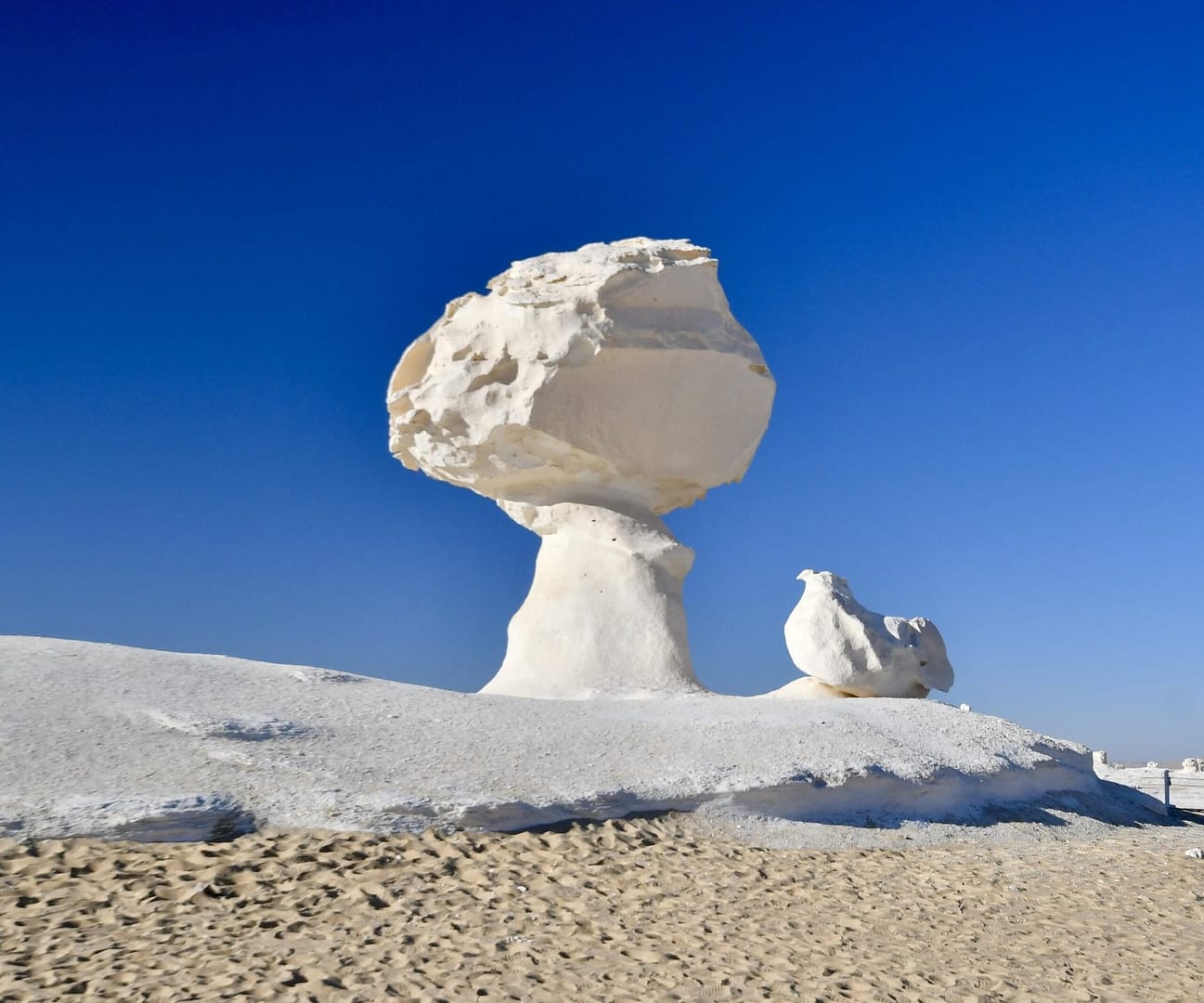Nestled in Egypt’s expansive Western Desert lies a natural marvel that captivates travelers with its surreal beauty—the White Desert. Known locally as Sahara el Beyda, this unique landscape offers an otherworldly experience, far removed from Egypt’s more frequented historical sites. In this comprehensive guide, we’ll explore the White Desert’s origins, its mesmerizing features, nearby attractions, and practical tips for an unforgettable visit.
Unveiling the White Desert: A Geological Wonder
Approximately 370 kilometers south of Cairo and 20 kilometers northeast of the Farafra Oasis, the White Desert stands as a testament to nature’s artistic prowess. This protected area, officially designated as the White Desert National Park in 2002, spans vast stretches of white sands and chalk formations that have been sculpted over millennia.
The Birth of a Desert
Many many years ago, the White Desert was submerged under a vast ocean. As the waters receded, they left behind thick deposits of marine sediments, primarily chalk and limestone. Over time, wind and sand erosion carved these deposits into the stunning formations we see today.
Nature’s Sculptures: The Iconic Rock Formations
The desert is adorned with an array of chalk rock formations, each uniquely shaped by the elements. Some of the most renowned include:
- The Mushroom: Resembling a giant mushroom, this formation showcases the power of wind erosion, with a broad cap perched atop a slender stem.
- The Chicken and the Tree: A whimsical formation that, with a bit of imagination, looks like a chicken standing beside a tree.
- The Ice Cream Cone: A cone-shaped structure that evokes images of a classic ice cream treat.
These natural sculptures, set against the backdrop of the desert’s white sands, create a landscape that feels both alien and enchanting.
Beyond the White Sands: Nearby Natural Wonders
While the White Desert is the star attraction, the surrounding areas offer additional sites worth exploring:
The Black Desert
Located approximately 134 kilometers north of the White Desert, the Black Desert presents a stark contrast with its dark volcanic hills and black-topped sand dunes. The landscape is dotted with basalt and dolerite rocks, remnants of ancient volcanic activity.
Crystal Mountain
En route between the Bahariya Oasis and the White Desert lies Crystal Mountain, a ridge gleaming with quartz crystals. Often referred to as the “Jewel of the Desert,” it’s a popular stop for travelers to admire and collect shimmering crystal fragments.
Farafra Oasis
The closest oasis to the White Desert, Farafra offers a glimpse into traditional Bedouin life. Visitors can explore mud-brick houses, local markets, and the Badr Museum, which showcases the works of a local artist inspired by the surrounding desert.
Experiencing the White Desert: Activities and Adventures
A visit to the White Desert offers a plethora of activities that cater to both adventure seekers and those looking to immerse themselves in tranquility:
Camping Under the Stars
One of the most sought-after experiences is camping amidst the chalk formations. As night falls, the desert transforms into a serene landscape illuminated by a canopy of stars. The absence of light pollution makes it an ideal spot for stargazing.
Desert Safaris
Embark on a 4×4 safari to navigate the undulating terrains of the White Desert. Experienced guides lead visitors through the most iconic spots, sharing insights into the geology and history of the area.
Photography Expeditions
The unique interplay of light and shadow, especially during sunrise and sunset, offers photographers a dreamscape. The golden hues juxtaposed against the white chalk formations create mesmerizing visuals.
Planning Your Visit: Practical Tips
To ensure a memorable and safe journey to the White Desert, consider the following:
Best Time to Visit
The ideal time to explore the White Desert is between October and April when temperatures are milder. Daytime temperatures are pleasant, while nights can be chilly, so packing layers is advisable.
Permits and Regulations
As a protected area, visitors may require permits to enter certain parts of the White Desert National Park. It’s essential to check with local authorities or tour operators beforehand.
Choosing a Tour Operator
Opting for a reputable tour operator enhances the experience, ensuring safety and providing valuable insights. Many operators offer packages that include transportation, meals, and camping equipment.
Safety Precautions
- Hydration: The arid environment can lead to dehydration. Carry ample water and stay hydrated.
- Sun Protection: The desert sun can be intense. Use sunscreen, wear hats, and consider sunglasses to protect against UV rays.
- Navigation: The vastness of the desert can be disorienting. Always travel with a guide familiar with the terrain.
Conclusion
The White Desert of Egypt offers an unparalleled blend of natural beauty and serene solitude. Its unique landscapes, rich history, and the promise of adventure make it a must-visit destination for those seeking to experience the extraordinary. Whether you’re camping under a starlit sky, exploring

